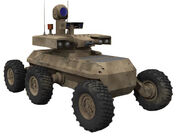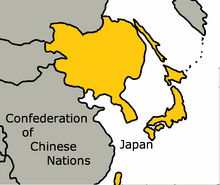"Hakko ichiu" | |||||||
| Anthem | "Kimigayo (君が代?)" | ||||||
| Capital | Kyoto | ||||||
| Largest city | Tokyo | ||||||
| Language | Japanese | ||||||
| Religion | Buddhism | ||||||
| Government | Constitutional Monarchy | ||||||
| Emperor | Akihito | ||||||
| Prime Minister | Naoto Kan | ||||||
| Population | 289,166,177 | ||||||
| Established | 1333 | ||||||
| Currency | Yen | ||||||
The Empire of Japan is a large nation in Asia, it has land borders with the Confederation of China, Mongolia and Great Buryatia. It also has maritime borders with Siam and New Westphalia and has colonies throughout the solar system.
History[]
The Shogunate[]
Imperial Restoration[]
Emperor Go-Daigo restored the imperial house to power in 1333 in a revolution. He quickly removed the power from the Shogunate and the Daimyo and restored power to a civilian government. To start with he stripped all power from the military and set up a new panel of advisors to act as the imperial court. This court was made up of those who had supported Go-Daigo's revolution but advised him that an elected body would bring more stability to the nation. Therefore, Go-Daigo set up a new panel called the Diet that would be elected by anyone who owned land. He was not bound to listen to the Diet but it did give him access to the views of the nation. This system has continued since then although the emperor's power has decreased while the Diet's has increased.
First Imperial Expansion[]
Between 1339 and 1600 the Japanese Emperor (with the advise of the Diet) invaded Korea and Taiwan. It developed strong trading links with western powers such as Spain and Sweden. From them they were able to combine Japanese ingenuity with western developments to modernize their military and the Japanese Navy and Army were soon able to secure positions in Korea and Taiwan after which they finally conquered both regions.
The end of the Imperial Monarchy[]
When the Diet tried to force through a piece of legislation that would have granted suffrage to all males, Emperor Go-Yōzei chose to exercise his right to veto it, something that had not been done since the days of Emperor Go-Hanazono. In response to this the Diet asked for a referendum on the Emperor's power. The Japanese constitution had stated that referendums had to be allowed to go ahead by the Emperor and that he would have to abide by it. Eventually the results came back in favour of the Emperor's power to being limited to strongly advising the Diet which was a complete reversal of its original task.
2nd Japanese Empire[]
After the World War the Japanese Empire had the opportunity to expand its empire and the Diet passed an act that asked the IJN, JA, IAF to increase their size and invaded Manchuria. The war was a quick and sudden victory for the Japanese Empire when it expand its size by a over half.
Space Exploration[]
Japan was one of the first powers to reach the stars launching its first satellites in the 1790s and putting a man in space a few years later. In 1800 the Empire put a man on the moon and claimed an area of it for Japan, in the following one hundred years Japan built its first moon base and several space stations in preparation for a mission to Mars in the 20th century. In 1905 Japanese uchūhikōshi (astronauts) landed on Mars' moons and on the planet itself. Both the moons and the planet have been in Japanese control ever since.
Government and Internal Politics[]
The Empire of Japan is a constitutional monarchy with the Emperor as the head of the Diet although he has little actual power. The Diet is made up of representatives from Japan's 65 prefectures. Each prefecture from the Japanese Islands (Including Taiwan) elects nine MP's while the prefectures outside the home world elect five for a total of 423 MP's. Traditionally Japan is defined as a social democratic nation with its progressive policies and welfare programs marking it out as a very left wing nation.
Economy[]
Fishing[]
Japan brings in the largest amount of fish and whale meat in the world with Japanese fishermen catching an estimated 40 million more metric tons of food than its nearest rival (Sweden). Many Japanese fishermen spend there entire lives on the water only returning to land to return there catch. Fishing makes up an estimated 10% of the Japanese GDP while fishermen and associated jobs are over 2% of the working Japanese population. Despite advances in technology that could theoretically make fishing entirely automated the Japanese have a strong sense of personal achievement when fishing so many fishermen/whalers still use traditional methods.
Interplanetary Mining[]
Japan occupies the largest share of the interplanetary mining business and the massive trade revenue that it brings in makes up 20% of Japan's GDP. However some of this money has to be paid to Sweden to use their Gotland-class interplanetary transports. Like many other Japanese industries the mining industry is mainly automated although well over 100,000 people in the Japanese colonies are involved in the industry.
Technology[]
Military[]
Army[]

IJA Dēmon Tank
The Imperial Japanese Army is surprisingly small considering the size of territory that they have to patrol. It is a fully voluntary army and its small manpower is made up by the fact that 90% of the IJA's combat units are made up of UGV's that are either controlled by a central computer or can be given simple programs. This allows the IJA to patrol an area that they would otherwise need 100,000's of men to patrol. However this does have some disadvantages, for example a single EMP blast would neutralise most of the smaller UGV's although the larger Tank UGV's have hard wired equipment and would be unaffected. The IJA also has a special forces branch which is entirely manned by humans.

IJA Gōsutosorujā Infantry Replacement Drone (IRV)
Technologically the IJA is slightly more advanced than the armies of its nearest rivals although it is inferior to the Swedish army and is smaller than the army of the Confederation of Chinese Nations. It operates the Dēmon UGV as its primary Drone MBT and also operates the O-VI Super Heavy Tank that is crewed by Humans. It operates the Gōsutosorujā Infantry Replacement Drone as its main anti-infantry vehicle/infantry replacement vehicle although it also has the Ka-Mi amphibious assault vehicle/IFV used by the Japanese Naval Infantry and some normal infantry units. The IJA also operates a single multipurpose Helicopter, the Han'yō koputā.
The IJA is made up of 12 infantry divisions of 10,000 men each, four manned tank divisions of 5000 each and the single Special Forces division of 8000. In addition to this the IJA has 30 IRV divisions of 5,000 vehicles and 20 Drone MBT divisions of 500 Tanks each. The IJA high command controls all of the IRV's and Drones from a central headquarters in Tokyo although command can be switched over to area commanders in their mobile headquarters.
Air Force[]

A IAF Carrier
The Imperial Air Force is entirely based around the Carriers of the IJN and the Airborne Aircraft Carriers of its own forces. It is tasked with protecting the airspace of Japan from incursions by opposition powers and in times of war is used to project Japanese power over other continents through the use of the aforementioned carriers. The IAF is traditionally holds the middle position in Japanese society, it is more popular and respected than the Army but less so than the Navy and receives funding representative of that position.

IAF Hypersonic Bomber
Unlike its ground complement the IAF is mostly made up of human crewed aircraft with only its anti-missile units being UAV's. Its main aircraft is the Senpū fighter/bomber that operates in both the IJN and IAF that can launch from both services aircraft carriers. It also operates the Furasshu hypersonic bomber that can reach bases on the moon and any place on earth in less than an hour although they can only be launched from ground bases.
The IAF is divided into twenty Air Fleets which are each centered around nine airborne aircraft carriers and one ground base. Each of these carriers has 100 fixed wing aircraft while the ground bases have a complement of 200 Multi-Role fighters and ten bombers.
[]

Atorantisu Submarine Carrier
The Imperial Japanese Navy is the largest, most powerful and popular of the Japanese armed forces. In addition the its duties as the protector of the Japanese Islands it is also responsible for the protection of the Mars colonies and of the Japanese space satellites. It is mainly based around aircraft carriers although the ground based IJN also has two battleships that are used to protect the home islands. It has traditionally occupied a massively popular position in the Japanese culture and in times of war the IJN is used to project Japanese power across the world and the planets of the solar system. As well as the Space Fleet (IJSF) and the Ground Force (IJNGF) the IJN also maintains an advanced technology department, the IJNXF.
The IJN's Space Fleet is newer and receives less publicity than the ground based navy (Although they are technically the same force) it has a similar role to the Ground Force however and receives more funding. Like the ground force it also bases its doctrine around aircraft carriers although in IJNSF practice they are simply referred to as Carriers.

A IJNSF Carrier
Like the IAF the IJN is primarily crewed by Humans, in fact the IJN makes up 1% of all Japanese people in work which is a massive two million. However this does include administrative jobs but even so is still a very impressive figure. The IJNGF uses the Farukon class Supercarriers as its primary capital ship but it also uses two of the Maunten class Battleships and these are supported by the Ten'nō class Cruisers, Puranto class Destroyers and the Furawā class Frigate. On board the carriers the Senpū fighter/bomber is used to project air superiority and to seek and destroy any enemy carriers.
The IJNSF uses the Supēsudoragon class Carriers as its main base of operations outside the atmosphere. These carriers use a modified version of the IJNGF Senpū fighter/bomber to patrol their assigned regions although they also have a battery of railguns to defend themselves against pirates. Aside from the aforementioned craft the IJNSF also uses a modified version of the Furasshu hypersonic bomber with a pressurised cabin and the Hoēru class space transport.
The IJNXF is a mixture of IJNSF and IJNGF experimental equipment united under a single command corps that oversees there construction and testing before they are passed on to the main IJN branches. Currently its main test project is the Atorantisu Submarine Carrier that when finished will replace the Farukon class. Other projects include a space cruiser to complement the IJNSF's carriers and purpose built fighter craft.
The IJN is divided into four ground fleets each with four capital ships and escorts, two space fleets with three carriers and the single IJNXF fleet which has no set structure.



